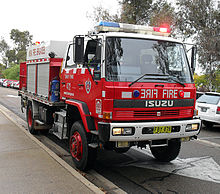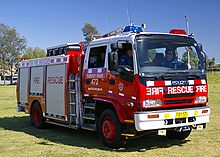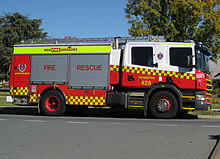- Fire and Rescue NSW
-
Fire and Rescue NSW Motto: 'Orta Recens Quam Pura Nites', (Newly Risen, How Brightly We Shine) Established 1884 Staffing 360 administrative and trades staff Strength 3000 full time and over 3400 retained firefighters Stations 339 Engines 264 Rescues 56 Helicopters 1 x BK 117 helicopter Fireboats 1 HAZMAT 27 Commissioner Greg Mullins AFSM Fire and Rescue NSW, formerly the New South Wales Fire Brigades, is a New South Wales government agency for firefighting in the major cities, metropolitan areas and towns across rural and regional NSW. Under the Fire Brigades Act 1989, Fire & Rescue NSW (FRNSW) also protect the State from hazardous material (HAZMAT) incidents and by extension of this capability, the consequences of terrorism. FRNSW provide a rescue capability across the State. FRNSW falls under the portfolio of the Minister for Emergency Services.
Fire & Rescue NSW is the seventh largest urban fire service in the world, with more than 6400 firefighters serving at 338 fire stations throughout the state, 360 support staff, and 3600 Community Fire Unit volunteers. It also works closely with the Rural Fire Service.[1]
On 1 January 2011 the NSWFB was re-named Fire and Rescue NSW to better reflect their expanding responsibilities.[2]
Contents
History
The New South Wales Fire Brigades (NSWFB) was established in September 1909, replacing the Sydney based Metropolitan Fire Brigade, which formed in February 1884.[3] Prior to its formation, Fire Brigade Boards also ran rudimentary fire services in various New South Wales country towns.
Emblem
The Fire and Rescue NSW emblem includes the NSW state emblem with the State motto 'Orta Recens Quam Pura Nites', which is Latin for 'Newly Risen How Brightly We Shine'.
A flag based on the British Blue Ensign with FRNSW emblem is also used.
Commissioner
Greg Mullins, AFSM, was appointed as Commissioner of the NSW Fire Brigades (Now Fire & Rescue NSW) on 4 July 2003. He is the first person in the history of the brigade to be appointed as both Chief Fire Officer / CEO, and to have come from the Brigades’ ranks. The official vehicle of the FRNSW Commissioner bears New South Wales number plate 10, which has been on continuous issue to the head of the fire department in NSW from the RTA since 1910.
Commissioner Mullins joined the then NSWFB in 1978 after serving for six years as a volunteer firefighter with the NSW Rural Fire Service. He rose steadily through the ranks serving in operational and specialist positions, becoming a Station Officer in 1990, a District Officer (Inspector) in 1992, a Superintendent in 1995, and an Assistant Commissioner in 1996 [1]. In 2000 he was appointed as Director State Operations. He has represented Australian fire services nationally and internationally on issues concerning emergency management, managing the consequences of terrorist attacks, and urban search and rescue.
Organisation
- Permanent Stations
A permanent firefighter is a full-time firefighter [2]. Permanent firefighters work in a fire station as part of a platoon. Each fire station has four platoons on rotating shifts each containing at least 3 firefighters of various ranks, plus a Station Officer. The number depends on the size and nature of the fire station. Each platoon is supervised by a Station Officer.
Each fire station is part of a Zone containing between nine and 27 fire stations and headed by a Zone Commander. These Zones are then grouped in Regions (North, South and West) headed by a Regional Commander.
- Retained Stations
A retained station is a part-time station where retained firefighters work. Even though these firefighters work part-time, it should be noted that these members of the community (who often have other full-time employment) are considered professional firefighters who have undergone training so they can attend the same jobs as permanent firefighters [3]. The retained station is not a permanently staffed station, meaning the firefighters are on-call from home or work rather than on duty at the station. However, retained stations respond to emergencies 24 hours a day. Retained firefighters use the same vehicles, equipment and uniforms as their permanent counterparts, the only visible differences being their shoulder and helmet ranks which are red as opposed to white/black.
- Mixed Stations
Some stations employ a mixture of Permanent and Retained Firefighters. This arrangement is common in larger country towns such as Bathurst and Orange where the nearest backup would otherwise be some distance away. The station would typically have one appliance manned by permanent staff as first response, with additional vehicles being manned by retained staff as required. The station may have Permanent day and night shifts or be day shift only, with retained staff manning all appliances at night when they are less hampered by work or other commitments.
- Community fire unit volunteers
Community fire units (CFUs) are volunteer teams of local residents trained to safeguard their homes during a bushfire, until the fire brigades can get there, or to 'mop up' after a fire has passed so fire units can be released to attend more urgent incidents. CFU members are not firefighters [4]. The aim of the CFU program is to reduce the impact of bushfires on the community and to protect life and property from bushfires. A typical team is made up of six to 12 members. Recruitment is within the local community. Local fire stations conduct regular training sessions with volunteers. The training focus is on bushfire education, prevention and preparation.
Area of service in New South Wales
Fire and Rescue NSW has 339 stations across NSW protecting 90% of the State's population[citation needed].
- Rescue
Fire and Rescue NSW conduct a variety of rescue operations state wide, ranging from the release of persons from transport, domestic and industrial incidents to animal rescues. In addition there are specially trained teams that carry out swift water, alpine and vertical rescues and Urban Search and Rescue (USAR). FRNSW Rescue also works in conjunction with other government agencies including the NSW Police Force, Ambulance Service of NSW, the NSW Rural Fire Service and the State Emergency Service. The FRNSW Urban Search and Rescue Taskforce has been registered by the United Nations for international deployment to assist in disaster situations, particularly earthquakes,throughout the Asia-Pacific region [5].
- Hazardous materials (HAZMAT)
Fire and Rescue NSW is responsible for protecting the whole of New South Wales from hazardous materials (hazmat) incidents. We have the authority to attend, combat and render safe any land-based or inland waterway spillage of hazardous materials within the State.
All fire stations are equipped with trained personnel and resources for dealing with hazmat incidents. Each fire station receives hazardous materials awareness training and equipment to combat minor spills of hydrocarbons, gas leaks and emergency decontamination procedures. Fire and Rescue NSW has six specialist heavy Hazardous Materials Response Units operating from Sydney (Greenacre, Alexandria & St Marys), Newcastle, Berkley Vale and Shellharbour. They have advanced capabilities in detection of toxic industrial chemicals, volatile substances and chemical warfare agents.
Intermediate hazardous materials response is delivered by 14 strategically located units, including six with a waterways response capability. Each unit is equipped with detection equipment and has the capability to access chemical databases with information on chemical, biological, radiological and toxic industrial chemical substances.
- Bushfire/Natural Hazards
Fire and Rescue NSW supports the Rural Fire Service of NSW during and after bushfires in New South Wales.
The FRNSW Counter-terrorism and Aviation Unit was established in March 2003 to manage the planning, development and implementation of the counter-terrorism and aviation capability.
Fire and Rescue NSW jointly funds and operates a BK 117 helicopter in partnership with the NSW Police Aviation Support Branch. The helicopter's primary role is response during the crisis and consequence management phases of a terrorist event. It also provides general air transport of both equipment and personnel for complex and/or protracted hazardous materials or rescue incidents and firefighting operations.
- Fire investigation and research
FRNSW’ Fire Investigation and Research Unit (FIRU) provides a range of investigative and research services to both internal and external customers including research into human and structural behaviour during fire, and the associated impacts for performance based building design. The Fire Investigation and Research Unit assists with determining fire causes and liaises closely with Police and other investigators.
Fire Engines (Appliances)
All FRNSW appliances (fire engines) are custom designed. The specialised equipment to be carried on appliances is drawn from a standardised listing which forms a managed inventory and is specific to each appliance type and model. Standardisation of inventory is extremely important as this ensures equipment is stowed in an approved and ergonomic manner. It is also ensures the appliance is not overloaded and is within its legal load carrying capacity.
Pumpers
- Tanker Class 1 (4x4)
Chassis Make & Model: Isuzu FTS750 Body Manufacturer: Mills Tui Australia Pty. Ltd., Queensland Commissioned: 2003-2004 (8 Vehicles) Crew Capacity: 6
- Pumper Class 2 (Previously "Pumper Type 2")
Chassis Make & Model: Isuzu FTR800 Body Manufacturer: Skilled Equipment Manufacturing Ltd. Commissioned: 1999-2003 (139 Vehicles) Crew Capacity: 6
- Pumper Class 3 (Varley Commander) (Previously "Pumper Type 3")
Chassis Make & Model: VSV Commander Mk3 Body Manufacturer: Varley Specialised Vehicles Ltd. Commissioned: 2001 - 2005 (52 Vehicles) Crew Capacity: 6
- Pumper Class 3 (Scania)
Chassis Make & Model: Scania Body Manufacturer: Varley Specialised Vehicles Ltd. (1 unit), SEM Fire and Rescue (Up to 84 units) Commissioned: 2008- (Up to 85 units currently in production) Crew Capacity: 5
- Pumper Class 3 (Scania P94D) (Previously "Pumper Type 4")
Chassis Make & Model: Scania P94 DB4x2NA 310 Crew Cab Body Manufacturer: Australian Fire Company Commissioned: 2000 - 2001 (12 Vehicles) Crew Capacity: 5
- Pumper Class 3 (Varley Commander) (Previously "Pumper Type 4")
Chassis Make & Model: VSV Commander Mk2 Body Manufacturer: Varley Specialised Vehicles Ltd. Commissioned: 2000 - 2004 (37 Vehicles) Crew Capacity: 6
- Pumper Class 3 (Varley Commander SP) (Previously "Pumper Type 5")
Chassis Make & Model: VSV Commander Mk2 Body Manufacturer: Varley Specialised Vehicles Ltd. Commissioned: 2000 (12 Vehicles)
-
- In 2008 the then NSWFB changed the way it designated its pumping appliances.
Prior to the change, there were:
Tankers (4*4 Ind pump). Isuzu 4*4 FRS, FTS & FTS750. Type 1 (4*2 Ind pump). Isuzu FTR800. Type 2 (4*2 Pto medium pump), Isuzu FTR800 & FTR900. Type 3 (4*2 Pto Medium / Urban pump), Inter 1810 & 2250, Austral Firepac, Scania 93M, Varley Commander II, Mercedes 1625, Volvo F17 Type 4 (4*2 Pto Urban pump) Scania 94D, Varley Commander I Type 5 (4*2 Pto Super Pump). Varley Commander I SP. Any type of appliance could be further specialised with rescue or hazmat equipment.
Due to the differences between several types being only minor, and the 4*2 Type 1 being withdrawn and rebuilt as rescue appliances, the system was simplified into 3 basic classes:
Class 1 - 4*4 Tankers (standard, Rescue & Hazmat variants), Isuzu 4*4 FRS, FTS & FTS750. Class 2 - 4*2 Medium Pumper (standard & Rescue), Isuzu FTR800, Inter 1810 Class 3 - 4*2 Urban Pumper (The old types 3, 4 & 5, in standard, rescue and Hazmat variants). Inter 2250, Austral Firepac, Scania 93M, 94D & P310, Varley Commander I & II, Mercedes 1625, Volvo F17
Aerials
- Aerial Pumper
Chassis Make & Model: Scania P94 Body Manufacturer: Alexander Perrie & Co. Pty. Ltd. Commissioned: 2009- (Up to 3 vehicles currently in production) Crew Capacity: 5
- Aerial Pumper
Chassis Make & Model: Scania P94 GB6x4NB 310 Body Manufacturer: Mills-Tui Ltd., New Zealand Commissioned: 2000-2001 (10 Vehicles) Crew Capacity: 5
- Turntable Ladder
Chassis Make & Model: Iveco EuroMover 190 E 34 Body Manufacturer: Iveco Magirus AG / Varley Spec. Vehicles Commissioned: 2001 - 2003 (2 Vehicles) Crew Capacity: 2
- Aerial Ladder Platform 37m (Mercedes/Bronto)
Chassis Make & Model: Mercedes Benz K2435 Body Manufacturer: Alexander Perrie & Co. Pty. Ltd. Commissioned: 1996 - 2001 (6 Vehicles) Crew Capacity: 2
- Aerial Ladder Platform 37m (Scania/Bronto)
Chassis Make & Model: Scania P124 GB 8x4 Body Manufacturer: Alexander Perrie & Co. Pty. Ltd. Commissioned: 2004 (1 Vehicle) Crew Capacity: 2
- Aerial Ladder Platform 27m (Scania/Bronto)
Chassis make & Model: Scania P94 GB 4x2 Body Manufacturer: Alexander Perrie & Co. Pty. Ltd. Commissioned: 2004 (1 vehicle)
Hazardous Materials (HAZMAT)
- BA Training Trailer
Chassis Make & Model: Mercedes Benz Actros 2648 (6x4) Trailer Manufacturer: Maxicube Trailers Pty. Ltd. Commissioned: 1999 (1 Vehicle) Crew Capacity: 2
- Heavy HazMat (Austral Firepac)
Chassis Make & Model: Austral Firepac 3500 Body Manufacturer: Austral Specialised Vehicles Commissioned: 1997 (1 Vehicle) Decommissioned: 2009 Crew Capacity: 2
- Heavy HazMat (International)
Chassis Make & Model: International 1850G LPV Body Manufacturer: Mills-Tui Limited (New Zealand) Commissioned: 1999 - 2000 (3 Vehicles) Moved to Service-Exchange (SEV) status: 2009 Crew Capacity: 3
- Heavy HazMat (Isuzu)
Chassis Make & Model: Isuzu 950 Long Body Manufacturer: Varley Specialised Vehicles Commissioned: 2007 - 2008 (6 Vehicles) Crew Capacity: 2
- C02
Chassis Make & Model: Isuzu FRR550 Crew Cab Body Manufacturer: Mills-Tui Limited (Australia) Commissioned: 2001 (1 Vehicle) Crew Capacity: 3
- HazMat Van
Chassis Make & Model: Mercedes Benz Sprinter 413CDI high roof Body Manufacturer: Caddy Storage Systems Commissioned: 2000-2002 (22 Vehicles) Crew Capacity: 2
Rescue
- Heavy Rescue (Isuzu)
Chassis Make & Model: Isuzu FVR1000 Body Manufacturer: Mills Tui Limited (Australia) Commissioned: 2009-(3 Vehicles currently in production) Crew Capacity: 2
- Heavy Rescue (Isuzu)
Chassis Make & Model: Isuzu FVR950 Heavy Duty Body Manufacturer: Austral Specialised Vehicles Commissioned: 2000 - 2001 (10 Vehicles) Crew Capacity: 2
- Heavy Rescue (Austral)
Chassis Make & Model: Austral Firepac 3500 Body Manufacturer: Mills-Tui Limited (Australia) Commissioned: 1997 (3 Vehicles) Crew Capacity: 2
- City of Sydney Varley Rescue
Chassis Make & Model: VSV Commander Mk2 Body Manufacturer: Varley Specialised Vehicles Ltd. Commissioned: 2001 (1 Vehicle) Crew Capacity: 6
- Rescue Van
Chassis Make & Model: Mercedes Benz Sprinter 413CDI high roof Body Manufacturer: Caddy Storage Systems Commissioned: 2000-2002 (42 Vehicles) Crew Capacity: 2
- Modular (Pod) Transport System
Chassis Make & Model: International 2350G Body Manufacturer: Commercial Engineering and Technology /Cooks Body Works Pty. Ltd. Commissioned: 1999 (2 Vehicles) Crew Capacity: 3
- USAR 1
Chassis Make & Model: Mercedes Benz Actros 2653 (6x4) Body Manufacturer: Peki Transport Equipment Pty. Ltd Commissioned: 2004 (1 Vehicle) Crew Capacity: 2
- FireAir 1
Kawasaki BK 117 helicopter Officially commissioned 7 December Jointly owned by Fire and Rescue NSW and NSW Police and used for the rapid deployment of specialist resources for tactical operations, forensic services, bomb disposal, chemical, biological, and radiological detection/decontamination, and urban search and rescue.
- Incident Control Vehicle
Chassis Make & Model: MAN 11.160 HOCL Body Manufacturer: PMC (Adelaide), Fitted out by Fire and Rescue NSW Commissioned: 1997-1998 (2 Vehicles) Crew Capacity: 3
Uniform
As well as the obvious danger of heat, firefighters are exposed to toxic fumes, sharp objects, uneven ground, slippery surfaces, biological fluids, spilt chemicals and electricity [6]. Due to these hazards, firefighting uniforms need to provide the best possible protection. Firefighting ensembles are known as Personal Protective Equipment (PPE) and generally consist of the following items: Tunic, flash hoods, boots, helmet, gloves, breathing apparatus, overtrousers and other assorted items such as bushfire jackets, high-visibility safety vests, cold and extreme climate clothing, and wet weather clothing [7].
See also
References
- ^ Biography - NSW Fire Brigades
- ^ "NSW firies get a new name". Herald Sun. 17 December 2010. http://www.heraldsun.com.au/news/breaking-news/nsw-firies-get-a-new-name/story-e6frf7jx-1225972504860. Retrieved 17 December 2010.
- ^ History of City of Sydney Fire Station (NSWFB website)
External links
 Media related to Fire and Rescue NSW at Wikimedia Commons
Media related to Fire and Rescue NSW at Wikimedia Commons- Fire & Rescue NSW official website
- NSW Rural Fire Service Website
- Museum of Fire
- NSW Fire Brigade Employees Union
- Unofficial Fire and Rescue NSW "HAZMAT" page
- Station 86 (Penrith) homepage
- Station 63 (Blacktown) homepage
- NSW Fire Brigade Training Facility 33°54′19″S 151°12′3″E / 33.90528°S 151.20083°E
Fire services in Australia Victoria New South Wales New South Wales Rural Fire Service · List of NSWRFS Brigades · NSWRFS Section 44 · Fire and Rescue NSW
South Australia Queensland Queensland Fire and Rescue ServiceOther states &
national organisationsCategories:- Government agencies of New South Wales
- Emergency services in New South Wales
- Fire and Rescue services of Australia
- 1884 establishments
Wikimedia Foundation. 2010.







